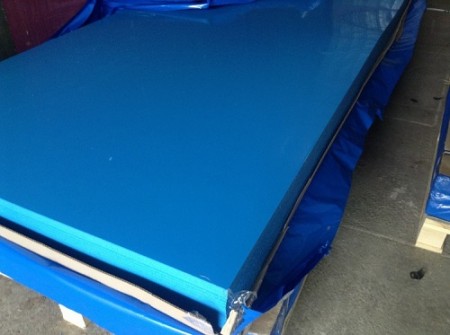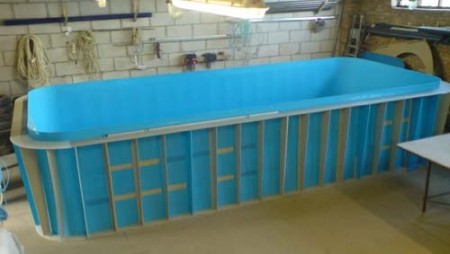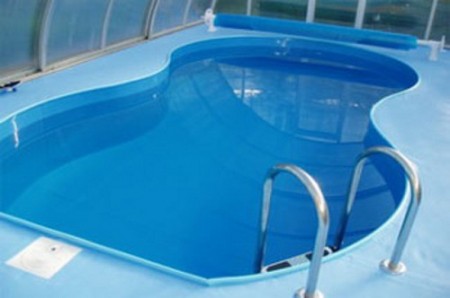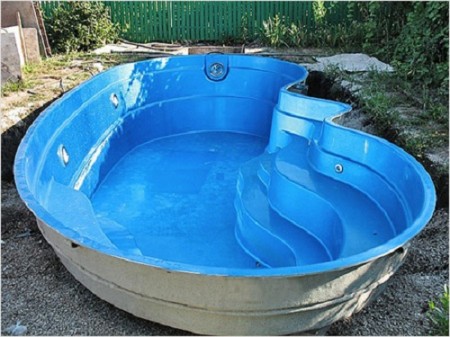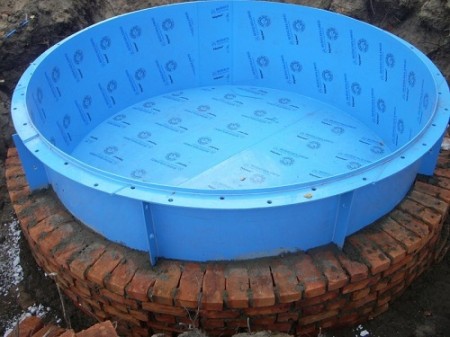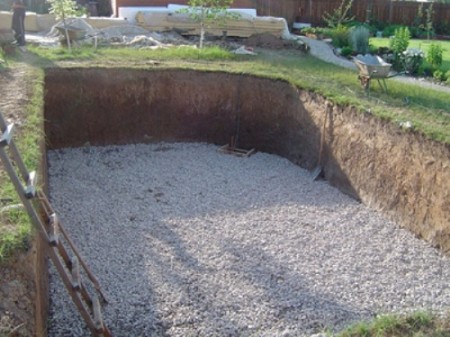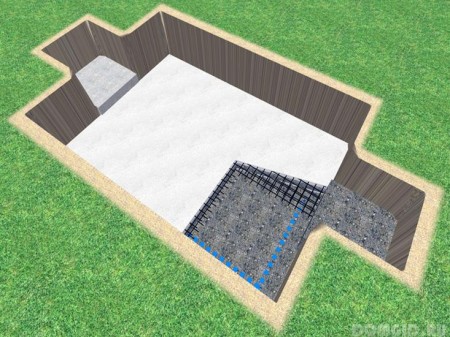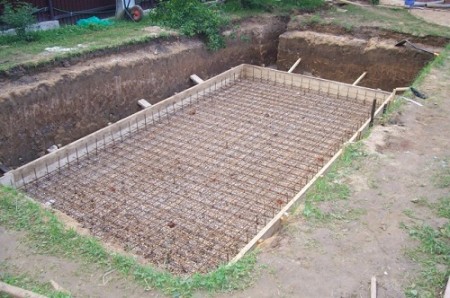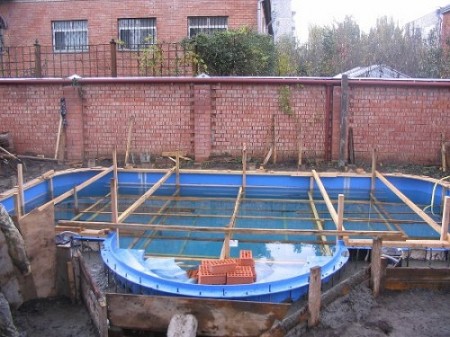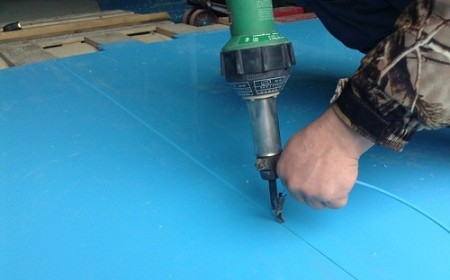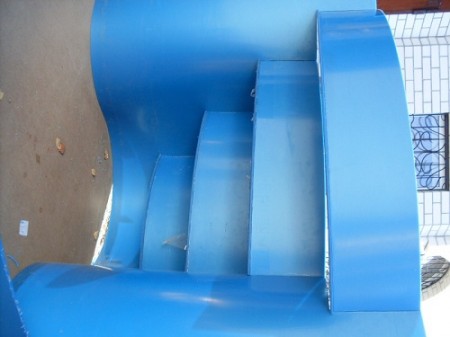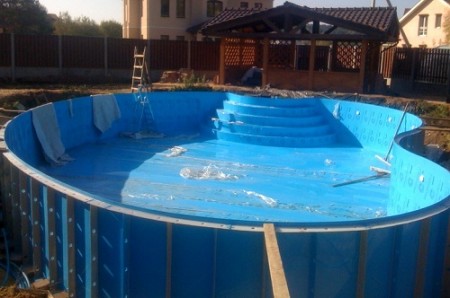Polypropylene is one of the types of plastic, the scope of which is extremely wide. It is used in engineering, electrical engineering, medicine, and, of course, in construction. This inexpensive, durable, mechanically damaging material is excellent for constructing artificial reservoirs, including open and closed pools. Excellent operational properties of pools of polypropylene allow to compete on an equal footing with reinforced concrete, demountable, frame and fiberglass structures.
Content
- 1 Sheet polypropylene for swimming pools: characteristics and properties of the material
- 2 Polypropylene Pools
- 3 Pool of polypropylene: choice of the size and shape of the bowl
- 4 Technology of polypropylene basin production: foundation pit preparation
- 5 Installation of the pool bowl
- 6 Pool of polypropylene own hands
Sheet polypropylene for swimming pools: characteristics and properties of the material
Pools made of polypropylene have been very popular recently, as the reservoirs of this material have excellent waterproofing, a long service life and have an attractive appearance. In terms of reliability, they are in no way inferior to expensive reinforced concrete structures. Pools are made from polypropylene sheets of standard size - 4x1.5 meters, having a thickness of 5 and 8 millimeters.
Polypropylene, as a building material, has many advantages:
- High resistance to temperature changes. Polypropylene, which is used in the construction of swimming pools, does not change its properties from -40 to +85 degrees.
- High strength of the material. Polypropylene is able to withstand sufficiently high static loads.
- Polypropylene does not conduct electricity, it can be used as an insulator.
- High resistance to aggressive chemicals. The material has a good "immunity" to the effects of alkalis, acids, gases and liquid metals.
- Polypropylene has the lowest density among all plastics.
- Ecological compatibility. The material is absolutely non-toxic, it is widely used for making containers for food and drinking water.
- Convenience in work. Polypropylene is very easy to handle - cut, drill, weld.
Polypropylene Pools
If you are the owner of a suburban or suburban site, and want to acquire your own pool, be sure to consider the "polypropylene version". The reasons to stop the choice on a design from polypropylene are enough:
- The finished structure does not need waterproofing.
- Polypropylene poorly conducts heat - the water in the pool retains its temperature longer, which saves on heating the pool.
- You can not drain water for the winter, because the material has a very high resistance to negative temperatures. If desired, a pool of polypropylene in winter can be used as a skating rink or a small hockey ground.
- The surface of the pool is not slippery, does not burn out under the influence of sunlight.
- Low probability of the appearance of algae, mold and fungi - saving on chemicals.
- Thanks to modern mounting technologies, it is possible to create a design of any shape.
- The ready pool without problems is completed with the necessary equipment - nozzles, a skimmer, lighting devices.
- The pool of polypropylene is mounted much faster and costs almost three times cheaper than the analog of reinforced concrete.
- Maximum installation time of the pool does not exceed two weeks.
- A pool of polypropylene sheets can be made by yourself.
Pool of polypropylene: choice of the size and shape of the bowl
As we noted above, thanks to the high plasticity of the material, you can realize the most original and bold ideas, and make a pool of any shape. The scale of the future reservoir largely depends on its location and destination. So, a large bowl is needed if it is planned to create a stationary full-function swimming pool. A medium-sized bowl is suitable for a small family pool. Small containers can be used to create a small decorative pond, a sauna bath, or a whirlpool bath.
The pool form should be selected based on the configuration of the site and the surrounding landscape. In principle, the choice of shape is limited only by your imagination, it can be any - round, square, triangular, in the form of bean grain, irregular in shape as a natural reservoir. Of course, making a complex bowl of the basin is a laborious process, you need to have the skills and experience of working with polypropylene. It is rather inconvenient to look after the pool of non-standard form - it is more difficult to clean it from garbage, it is necessary to accurately calculate the power of filters, you will have to buy additional care products more often.
The most common and optimal forms of bowls for pools of polypropylene are round, oval and rectangular. It is not at all necessary to build a non-traditional pool on your site - the simplest design can be decorated with additional elements - steps, handrails, make a multi-level bottom, etc.
The depth of the home pool often does not exceed 1.5 meters, although if you want you can make a pool basin with your own hands and with other parameters. If small children swim in the pool, it is necessary to make a site where the depth will not exceed one meter.
If you like to jump into the water from a springboard, then in the area of its placement depth should be at least three meters.
Technology of polypropylene basin production: foundation pit preparation
Choosing a site for the future pool, it is best to give preference to the place with clay soil. Nearby there should be no trees and tall shrubs, the leaves and branches of which will clog the water. After you have decided on the choice of location, proceed to the construction of the excavation.
The process of work is divided into several stages:
- We make the layout of the future pit. An important point - the width and length of the pit should exceed the size of the future basin bowl by about one meter.
- We dig the foundation pit - manually or with the help of machinery. The depth should be greater than the height of the future bowl by 50-60 centimeters.
- The bottom of the finished pit should be carefully leveled, covered with small rubble and rammed.
- We make reinforcement from the reinforcement. Optimum - from rods section 30 mm.
- After the grid is ready from the fittings, the bottom of the future pool is poured with concrete. The thickness of the layer is not less than 30 centimeters.
- On a concrete screed we lay a layer of geotextile, on top - a layer of a heat insulator. These can be sheets of inexpensive foam or styrofoam. Sheets of the heat insulator must be bonded together with adhesive tape or paper clips.
Installation of the pool bowl
If the pool is large, the bowl is assembled from the parts directly in the prepared pit. Small bowls are installed entirely. After the body of the future reservoir is installed in the foundation pit, additional equipment is being installed - filters, injectors, lighting, etc. After that all the nozzles are taken out to a separate room, designed for maintenance.
After that, the basin bowl is attached as follows:
- First of all, spacers are installed inside the bowl, which will ensure the stability of the structure.
- All pipes are protected with special sleeves.
- On the perimeter of the bowl a formwork is installed, inside of which reinforcement is made.
- The pool is filled with water by 30-40 centimeters.
- Inside the prepared formwork concrete is poured, the layer of which should not exceed 30 centimeters.
- After solidification of the first layer of concrete, another 30 centimeters of water are added to the basin, after which the formwork is concreted to the same height. Thus, the outer walls of the pool are filled to the required height.
- After the concrete is completely frozen, the formwork is dismantled, the territory next to the pool is ennobled - decorated with tiles, planted with a lawn or flowers, installed lighting fixtures, etc.
Pool of polypropylene own hands
A pond of polypropylene sheets, with little experience and skills, can be done on your own.
The following materials and tools will be needed:
- Polypropylene in sheets. Dimensions - 4x1.5 meters thick 8 millimeters (thickness of polypropylene depends on the size of the pool). Buy polypropylene sheet can be in the form of ready-made on-board systems of the required size from the manufacturer.
- Soldering iron for polypropylene with nozzles.
- Rod of polypropylene for welding sheets.
- Saw or jigsaw for cutting polypropylene sheets.
It should be noted that the tool for working with polypropylene is quite expensive, so it will be better not to buy it, but to lease it.
The technology of assembling the bowl of a pool of polypropylene
- First you need to draw a drawing of the future reservoir, in which all the parameters are marked - height, width, radius, etc.
- The steps are schematically displayed. Preferably do not hinged, and stationary steps inside the pool - they are more comfortable and look very nice.
- The base of the reservoir is made - sheets of polypropylene are welded and laid on the bottom of the pit. After that, on the basis draw a contour of the future bowl.
- After this, the web is cut and welded strictly along the marked contour from the outside.
- The spacers inside the bowl are installed, after which the walls are centered relative to the bottom of the basin.
- Steps are being prepared. Joints from the inside of each step are welded using a polypropylene rod. On the outside, the steps are welded with a seam nozzle, which has an angle of 90 degrees. The finished steps are welded to the side of the bowl.
- When the ladder is ready, the stiffeners are welded in steps of approximately 60 centimeters.
- The walls of the finished bowl are insulated with foam or expanded polystyrene.
That's all, the bowl of polypropylene for the future pool is ready. What to do next, we told above - to dissolve communications, pour external walls, decorate the territory to your liking, and enjoy water procedures in your own created reservoir.



